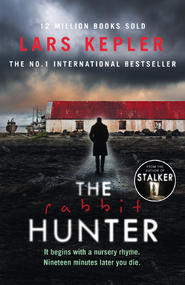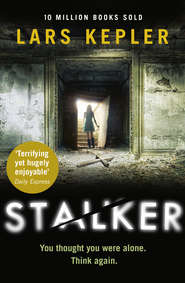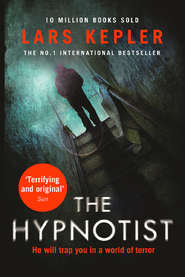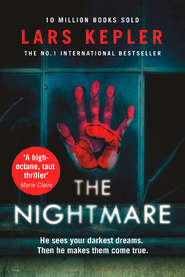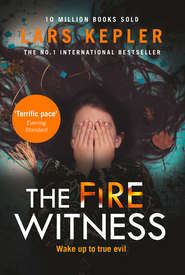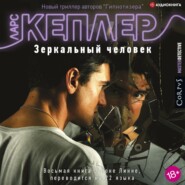По всем вопросам обращайтесь на: info@litportal.ru
(©) 2003-2025.
✖
The Sandman
Автор
Год написания книги
2019
Настройки чтения
Размер шрифта
Высота строк
Поля
‘Is Jurek Walter still locked up?’ was Joona’s first question.
‘Yes, he’s still in solitary confinement,’ Pollock had replied.
‘You’re sure?’
‘Yes.’
‘What about the boy? How do you know it’s Mikael Kohler-Frost?’ Joona had asked.
‘Apparently he’s said his name several times. That’s as much as we know … and he’s the right age,’ Pollock had said. ‘Naturally, we’ve sent a saliva sample to the National Forensics Lab—’
‘But you haven’t informed his father?’
‘We have to try to get a DNA match before we do that, I mean, we can’t get this wrong …’
‘I’m on my way.’
18 (#ulink_0eae9a9a-7394-5a66-87bb-7cb0822a2a3a)
The car sucks up the black, slushy road, and Joona Linna has to force himself not to speed up as his mind conjures up images of what happened so many years before.
Mikael Kohler-Frost, he thinks.
Mikael Kohler-Frost has been found alive after all these years.
The name Frost alone is enough for Joona to relive the whole thing.
He overtakes a dirty white car and barely notices the child waving a stuffed toy at him through the window. He is immersed in his memories, and is sitting in his colleague Samuel Mendel’s comfortably messy living room.
Samuel leans over the table, making his curly black hair fall over his forehead as he repeats what Joona has just said.
‘A serial killer?’
Thirteen years ago Joona embarked on a preliminary investigation that would change his life entirely. Together with his colleague Samuel Mendel, he began to investigate the case of two people who had been reported missing in Sollentuna.
The first case was a fifty-five-year-old woman who went missing when she was out walking one evening. Her dog had been found in a passageway behind the ICA Kvantum supermarket, dragging its leash behind it. Just two days later the woman’s mother-in-law vanished as she was walking the short distance between her sheltered housing and the bingo hall.
It turned out that the woman’s brother had gone missing in Bangkok five years before. Interpol and the Foreign Ministry had been called in, but he had never been found.
There are no comprehensive figures for the number of people who go missing around the world each year, but everyone knows the total is a disturbingly large number. In the USA almost one hundred thousand go missing each year, and in Sweden around seven thousand.
Most of them show up, but there’s still an alarming number who remain missing.
Only a very small proportion of the ones who are never found have been kidnapped or murdered.
Joona and Samuel were both relatively new at the National Criminal Investigation Department when they started to look into the case of the two missing women from Sollentuna. Certain aspects were reminiscent of two people who went missing in Örebro four years earlier.
On that occasion it was a forty-year-old man and his son. They had been on their way to a football match in Glanshammar, but never got there. Their car was found abandoned on a small forest road that was nowhere near the football ground.
At first it was just an idea, a random suggestion.
What if there was a direct link between the cases, in spite of the differences in time and location?
In which case, it wasn’t impossible that more missing people could be connected to these four.
The preliminary investigation consisted of the most common sort of police work, the sort that happens at a desk, in front of the computer. Joona and Samuel gathered and organised information about everyone who had gone missing in Sweden and not been traced over the previous ten years.
The idea was to find out if any of those missing people had anything in common beyond the bounds of coincidence.
They laid the various cases on top of each other, as if they were on transparent paper – and slowly something resembling an astronomical map began to appear out of the vague motif of connected points.
The unexpected pattern that emerged was that in many of the cases more than one member of the same family had disappeared.
Joona could remember the silence that had descended upon the room when they stepped back and looked at the result. Forty-five missing people matched that particular criterion. Many of those could probably be dismissed over the following days, but forty-five was still thirty-five more than could reasonably be explained by coincidence.
19 (#ulink_ebafb7c6-a824-57c8-ad43-cf83736e7060)
One wall of Samuel’s office in the National Criminal Investigation Department was covered with a large map of Sweden, dotted with pins to indicate the missing persons.
Obviously they couldn’t assume that all forty-five had been murdered, but for the time being they couldn’t rule any of them out.
Because no known perpetrator could be linked to the times of the disappearances, they started looking for motives and a modus operandi. There were no similarities with cases that had been solved. The murderer they were dealing with this time left no trace of violence, and he hid his victims’ bodies very well.
The choice of victim usually divides serial killers into two groups: organised killers, who always seek out the ideal victim who matches their fantasies as closely as possible. These killers focus on a particular type of person, exclusively seeking out pre-pubertal blond boys, for example.
The other group comprises the disorganised killers – here it is the availability of the victim that counts. The victim primarily fills a role in the murderer’s fantasies, and it doesn’t particularly matter who they really are, or what they look like.
But the serial killer that Joona and Samuel were starting to envisage didn’t seem to fit either of these categories. On the one hand he was disorganised, because the victims were so varied, but on the other hand none of them was especially easy to get hold of.
They were looking for a serial killer who was practically invisible. He didn’t follow a pattern, and left no evidence, no intentional signature.
Days went by without the missing women from Sollentuna being found.
Joona and Samuel had no concrete proof of a serial killer that they could present to their boss. They merely repeated that there couldn’t be any other explanation for all these missing people. Two days later the preliminary investigation was downgraded and the resources for further work reallocated.
But Joona and Samuel couldn’t let it go, and started to devote their free time during the evenings and weekends to the search.
They concentrated on the pattern that suggested that if two people had gone missing from the same family, there was an increased risk of a further family member going missing within the near future.
While they were keeping an eye on the family of the women who had vanished from Sollentuna, two children were reported missing from Tyresö. Mikael and Felicia Kohler-Frost. The children of the well-known author, Reidar Frost.
20 (#ulink_4dcfe3e3-c046-5489-9908-b2d858c620be)
Joona looks at the petrol gauge as he passes the Statoil filling station and a snow-covered lay-by.
He remembers talking to Reidar Frost and his wife Roseanna Kohler three days after their two children went missing. He didn’t mention his suspicions to them – that they had been murdered by a serial killer whom the police had stopped looking for, a murderer whose existence they had only managed to identify in theory.
Joona just asked his questions, and let the parents cling onto the idea that the children had drowned.







